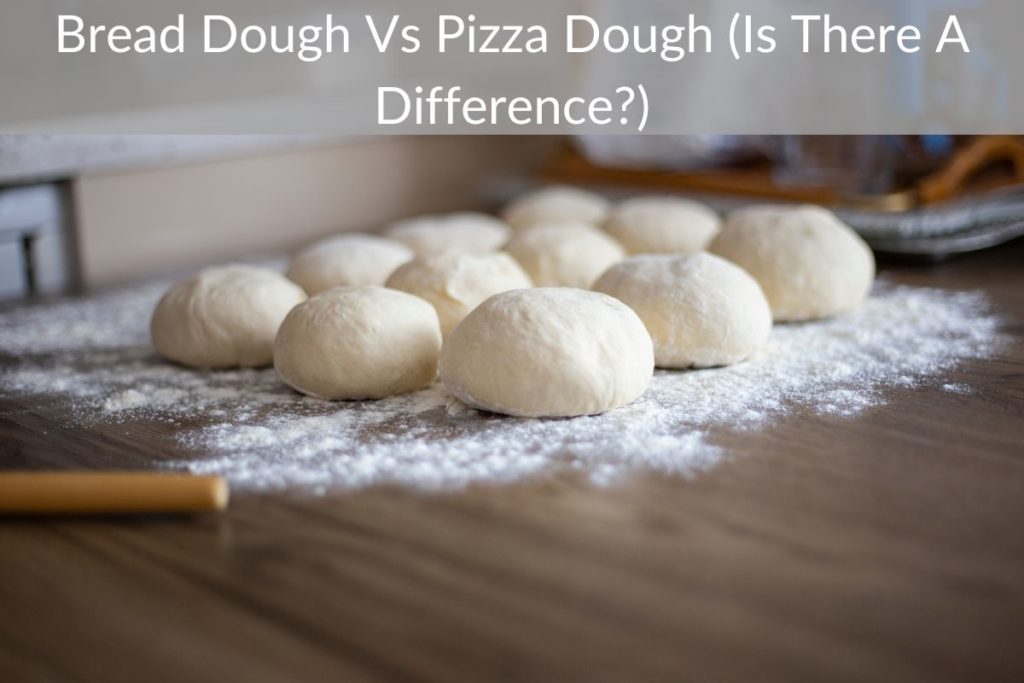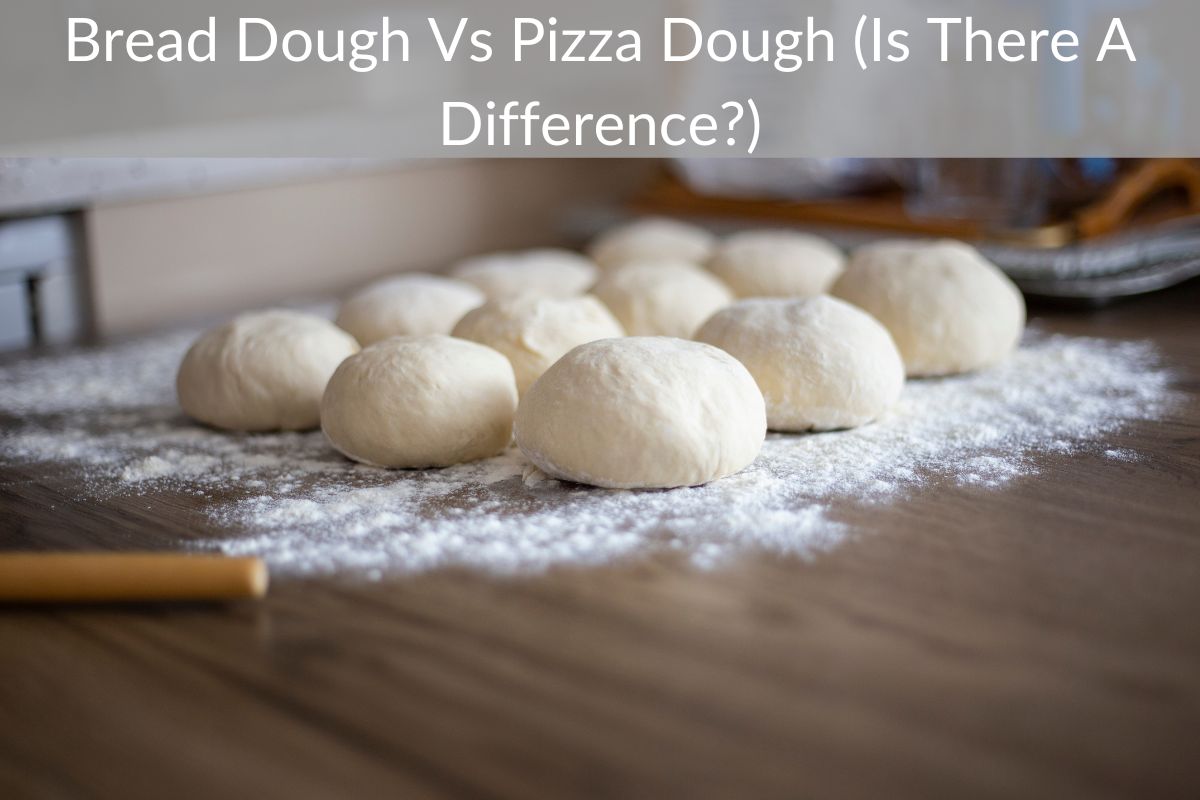There are several differences between bread dough and pizza dough. The two have different hydration levels, and the doughs differ in salt content and preservatives.
Read on to find out which one you should use. Bread dough tends to be sweeter, with cinnamon and brown sugar often added to the dough. Pizza dough is more elastic and can be shaped more easily.
This is a good choice if you’re planning to bake a lot of slices.

Bread dough
One of the biggest differences between bread dough and pizza crust is the ratio of water to flour. Bread dough can be up to 90% water, but it tends to rise faster than pizza dough. The dough is less dense than pizza crust, which means larger holes in the crumb.
Bread dough also has higher hydration, which makes it crispier and easier to form into a pizza base. In general, bread dough should be 50-70% water, while pizza dough is usually much drier.
Using bread dough is much easier than making pizza dough, but you need to be careful about what you add to your bread. A bread dough made with high amounts of sugar and eggs will burn and be hard to shape. A good pizza dough will have a high ratio of gluten and stretch, which means that it will hold up to a large amount of pressure.
This is especially true of dough designed for pizzas. The difference between bread dough and pizza dough comes down to personal preference and what you are looking for in a dough.
Both dough types require one or two additional rises before baking. A bread dough requires one to two proofs, and a third rise is required to get the dough to its full volume. Once risen, a pizza dough will need to be rolled out and topped.
Both types of dough need time to rise, so you must carefully watch their baking time. For pizza, a longer rise means a thicker crust.
The main difference between bread dough and pizza dough is the amount of gluten. Yeast provides the leavening power, which is the reason for the bread’s rising. This carbon dioxide gas creates a higher volume of air in the dough, making it softer and more flexible.
Extensibility is another difference between bread dough and pizza dough. Extensible dough is easier to stretch, while non-extensible dough can be too firm to stretch.
Variations in hydration levels
When comparing bread dough and pizza-making dough, you should always keep hydration levels in mind. Different flours absorb water at different rates, and a dough with 55% hydration will be nearly the same as a dough with 65% hydration.
A flour’s hydration level affects the consistency and flavor of the dough, so a higher hydration level is better for a softer, tastier dough.
The hydration level of a dough is a way to measure how much water is in it at the end of the baking process. A high hydration dough allows the gluten to stretch out completely, resulting in a dense and open crumb. High hydration doughs require good shaping skills and high levels of organic acids.
Some bread flours require more water than others, and a dough with 80% hydration is much more likely to become a loaf of bread with a rounded, dense crumb.
A good rule of thumb for pizza dough is to keep it between 60 and 70% hydration. This range helps keep the dough from becoming sticky and brittle during baking. The dough should not be overly dry, either. Too much hydration will result in a dense, chewy crust.
This range is best for home oven pizza makers, while professional bakers work with dough with high levels of hydration.
When comparing different hydration levels of bread dough and pizza dough, remember that high-hydration doughs require a very wet dough and ample strength. When mixing the dough, add water gradually to make it more elastic.
Changing the hydration level is most effective at the beginning of the mixing process. If you’re unsure about the correct hydration level for your dough, make sure to check the recipe carefully before you start making your pizzas.
The hydration level of bread dough is the key difference between bread and pizza dough. Many pizza makers refrigerate the dough for 24 hours before baking to enhance flavor, strengthen gluten, and extend its extensibility. Changing the ratios of these ingredients can also alter the style of your dough.
More water means stickier dough while less water makes your dough firmer. However, bread dough is usually baked the same day, so the longer you leave it to rise, the better.
Salt content
The difference between bread dough and pizza crust can be attributed to the amount of salt used in making the two types of dough. Salt tightens the gluten structure of the dough, which gives it strength and allows it to hold carbon dioxide that is released during the yeast fermentation process.
Without salt, dough becomes slack and sticky, which makes the dough difficult to work up and produces poor bread volume. Salt is essential in creating these characteristics in a bread dough.
While comparing the salt content of bread dough and pizza crust, one must keep in mind that less is better. Salt can slow the fermentation process, which can increase the overall flavor of the finished product. Traditionally, the fermentation process of Neapolitan pizza dough takes anywhere from eight to 24 hours.
However, a low-salt pizza dough is more tender and less salty. This difference is significant when comparing the salt content of bread dough vs pizza crust.
Adding a little water to the dough makes it softer and easier to shape, while adding more flour causes the dough to rise too much. The water ratio in bread dough is typically between 50 to 70%, whereas pizza dough has a maximum of 90 percent.
The higher the percentage of water, the crisper the crust. However, too much water will make the dough difficult to shape. The final result may also be a different texture.
The amount of salt in bread dough varies significantly, but a typical Neapolitan pizza dough contains around 2.5-3% salt. It’s critical to use a measuring spoon or gram scale when measuring salt. Using a tablespoon or measuring spoon doesn’t provide a reliable measurement, but it will give you a rough estimate.
The difference in salt content between bread dough and pizza dough is significant in terms of flavor, rise, and elasticity.
While the ingredients used for bread dough and pizza dough are similar, the process of making them differs. Yeast pizza dough is much more elastic and has a longer rise time. A yeast pizza dough has the same proportions of flour and sugar but uses yeast to create more gluten.
While bread dough is less elastic, pizza dough uses kneading to stretch the gluten and give the crust its shape.
Preservatives
Food manufacturers use chemical preservatives to extend the shelf-life of their products. Some are suspect of toxicity. But natural substances, such as lecithin, can help extend the shelf-life of food. Many natural preservatives are available in nature.
But finding them is a complicated task, because regulatory restrictions often hamper the development of new ones. If you are concerned about the safety of food you’re eating, look for the best alternatives.
While the concept of clean label has become popular in retail, food manufacturers are increasingly aware of its implications for restaurants. Restaurant operators are looking for ingredients that can help build consumer confidence. Whether they’re baking artisan bread or pizza, understanding what goes into the dough is key.
Even if you’re not a pizza purist, buying premade pizza dough from a grocery store won’t harm you. However, you can find premade dough at many small pizza places.
Unlike bread, which is baked the same day, pizza dough can be left out for a long time to rise. Pizza dough, on the other hand, can be chilled for a few days or weeks. Cold fermentation will increase flavor and strengthen the gluten in both types of dough.
Therefore, a longer fermentation is ideal for both bread and pizza. Alternatively, pizza dough may be baked the next day.
The use of synthetic l-cysteine reduces the number of cross-links between gluten-forming proteins and increases machinability. Inactivated yeast, glutathione, and ascorbic acid can reduce the work input of yeast dough. But they don’t reduce the elasticity of the dough.
Yeast dough is much more elastic than pizza dough. If it had no gluten, it would have a coarse crumb structure and low volume.
Potassium bromate is also a common ingredient in pizza dough and bread. While it’s not a toxic chemical, the potassium bromate it contains can damage DNA and cause tumors in rodents. Studies have linked potassium bromate to kidney and thyroid cancer. If you are unsure, check the label of your food products.
If it contains potassium bromate, make sure to avoid it as much as possible.

